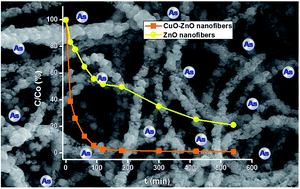Rapid and efficient removal of arsenic from water using electrospun CuO–ZnO composite nanofibers†
Abstract
Arsenic (As) contamination in water poses a serious threat to public health and other life on earth. To remove arsenic effectively from water, we synthesized CuO–ZnO composite nanofibers using a simple electrospinning technique assisted by post-calcination. The characterization of nanofibers was performed using field emission scanning electron microscopy (FE-SEM), transmission electron microscopy (TEM) and X-ray diffraction (XRD) analysis. The as-prepared nanofibers were further employed as nanoadsorbents for efficient removal of As from water. The favorability of the adsorption process and the maximum adsorption capacity were determined using Langmuir and Freundlich isotherm models. Moreover, the kinetic studies were performed to depict the rate of As sorption onto CuO–ZnO nanofibers. The initial pH of water and the presence of competing anions greatly affect the adsorption efficiency. Therefore, the adsorption experiments were conducted in varying pH environments and with different coexisting anions, such as phosphate, and nitrite. Such a nanofibers-based approach is quite interesting and can be beneficial in combating the current challenges of water pollution.



 Please wait while we load your content...
Please wait while we load your content...